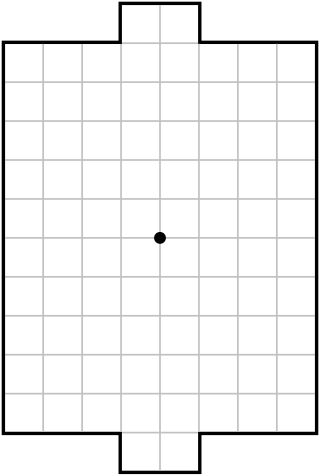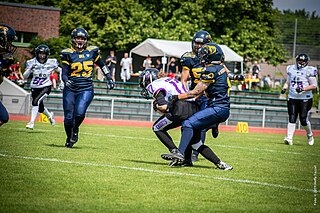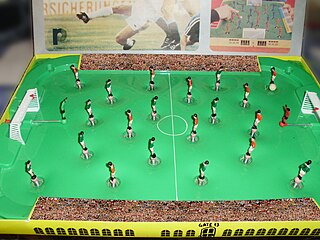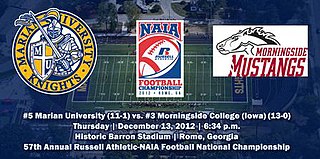
Canadian football, or simply football, is a sport in Canada in which two teams of 12 players each compete on a field 110 yards (101 m) long and 65 yards (59 m) wide, attempting to advance a pointed oval-shaped ball into the opposing team's end zone.

Touch football is an amateur variant of American football and Canadian football. The basic rules are similar to those of the mainstream game, but to end a down, the person carrying the ball need only be touched, instead of tackled, by a member of the opposite team. This rule change gave the game its name, to differentiate it from other variants. It is similar to street football, another amateur variant, however in street football full contact is allowed.

A touchdown is a scoring play in gridiron football. Scoring a touchdown grants the team that scored it 6 points. Whether running, passing, returning a kickoff or punt, or recovering a turnover, a team scores a touchdown by advancing the football into the opponent's end zone. More specifically, a touchdown is when a player is in possession of the ball, any part of the ball is in the end zone they are attacking, and the player is not down.

In sport, a goal may refer to either an instance of scoring, or to the physical structure or area where an attacking team must send the ball or puck in order to score points. The structure of a goal varies from sport to sport, and one is placed at or near each end of the playing field for each team to defend. For many sports, each goal structure usually consists of two vertical posts, called goal posts, supporting a horizontal crossbar. A goal line marked on the playing surface between the goal posts demarcates the goal area. Thus, the objective is to send the ball or puck between the goal posts, under or over the crossbar, and across the goal line. Other sports may have other types of structures or areas where the ball or puck must pass through, such as the basketball hoop. Sports which feature goal scoring are also commonly known as invasion games.

Gridiron football, also known as North American football, or in North America as simply football, is a family of football team sports primarily played in the United States and Canada. American football, which uses 11 players, is the form played in the United States and the best known form of gridiron football worldwide, while Canadian football, which uses 12 players, predominates in Canada. Other derivative varieties include arena football, flag football and amateur games such as touch and street football. Football is played at professional, collegiate, high school, semi-professional, and amateur levels.

In gridiron football, an onside kick is a kickoff deliberately kicked short in an attempt by the kicking team to regain possession of the ball. This is in contrast with a typical kickoff, in which the kicking team kicks the ball far downfield in order to maximize the distance the receiving team has to advance the ball in order to score. The risk to the team attempting an onside kick is that if it is unsuccessful the receiving team gets the ball and usually has a much better field position than with a normal kickoff.

Paper soccer is an abstract strategy game played on a square grid representing a soccer or hockey field. Two players take turns extending a line representing the position of a ball until it reaches one of the grid's two-goal spaces. A traditional paper-and-pencil game, it is commonly played in schools and can be found in some magazines. Many computer implementations of the game also exist. Despite the game's simple rules, paper soccer has various expanded strategies and tactics.
This is a glossary of terms used in Canadian football. The Glossary of American football article also covers many terms that are also used in the Canadian version of the game.
- Legally positioned at the kick-off or the snap. On kick-offs, members of the kicking team must be behind the kick-off line; members of the receiving team must be at least 10 yards from the kick-off line. On scrimmages, at the snap the offence must be behind the line of scrimmage; the defence must be at least one yard beyond the line of scrimmage.
- A player of the kicking team who can legally recover the kick. The kicker and any teammates behind the ball at the time of the kick are onside. Thus on kick-offs all players of the kicking team are onside, but on other kicks usually only the kicker is. The holder on a place kick is not considered onside.
- A defensive position on scrimmages, also called free safety. Typical formations include a single safety, whose main duty is to cover wide receivers. See also defensive back.
- A two-point score. The defence scores a safety when the offence carries or passes the ball into its own goal area and then fails to run, pass, or kick the ball back into the field of play; when this term is used in this sense, it is also referred to as a safety touch.

American and Canadian football are gridiron codes of football that are very similar; both have their origins partly in rugby football, but some key differences exist between the two codes.
Strategy is a major part of American football.

Gameplay in American football consists of a series of downs, individual plays of short duration, outside of which the ball is or is not in play. These can be plays from scrimmage – passes, runs, punts or field goal attempts – or free kicks such as kickoffs and fair catch kicks. Substitutions can be made between downs, which allows for a great deal of specialization as coaches choose the players best suited for each particular situation. During a play, each team should have no more than 11 players on the field, and each of them has specific tasks assigned for that specific play.

Penny football is a coin game played upon a table top. The aim of the game is for a player to score more goals with the pennies than their opponent.

Table football, also known as foosball or table soccer, is a tabletop game loosely based on association football. Its object is to move the ball into the opponent's goal by manipulating rods which have figures attached resembling football players of two opposing teams. Although its rules often vary by country and region when the game is played casually, competitive-level table football is played according to a unified code.

Pitchnut is a wooden tabletop game of French Canadian origins, similar to carrom, crokinole and pichenotte, with mechanics that lie somewhere between pocket billiards and air hockey.

A field goal (FG) is a means of scoring in gridiron football. To score a field goal, the team in possession of the ball must place kick, or drop kick, the ball through the goal, i.e., between the uprights and over the crossbar. The entire ball must pass through the vertical plane of the goal, which is the area above the crossbar and between the uprights or, if above the uprights, between their outside edges. American football requires that a field goal must only come during a play from scrimmage while Canadian football retains open field kicks and thus field goals may be scored at any time from anywhere on the field and by any player. The vast majority of field goals, in both codes, are placekicked. Drop-kicked field goals were common in the early days of gridiron football but are almost never attempted in modern times. A field goal may also be scored through a fair catch kick, but this is also extremely rare. In most leagues, a successful field goal awards three points.
The following terms are used in American football, both conventional and indoor. Some of these terms are also in use in Canadian football; for a list of terms unique to that code, see Glossary of Canadian football.

Tabletop football is a class of tabletop game simulating mainly association football, but also either of the codes of rugby, or some other form of football such as American football or Australian rules football. The games employ miniature figures of players on a bounded playing board or table that looks like a football pitch (field).

The 2012 NAIA Football National Championship was played on December 13, 2012 as the 57th Annual Russell Athletic NAIA Football National Championship. The game matched the once-beaten and 5th-ranked Knights from Marian University against the undefeated and 3rd-ranked Mustangs from Morningside College. The game matched two teams making their first appearance in the championship game, assuring someone would win the title for the first time. The teams proved to be evenly matched, and the outcome was not decided until the winning points were scored in the first round of overtime. With their winning field goal, the Marian Knights prevailed, 30-27 in the first overtime game in NAIA football championship history.
The 2012 Saint Francis Cougars football team represented the University of Saint Francis, located in Fort Wayne, Indiana, in the 2012 NAIA football season. They were led by head coach Kevin Donley, who served his 15th year as the first and only head coach in the history of Saint Francis football. The Cougars played their home games at Bishop John D'Arcy Stadium and were members of the Mid-States Football Association (MSFA) Mideast League (MEL). The Cougars finished tied for 1st in the MSFA MEL division and received an at-large bid to participate in the postseason NAIA playoffs.















